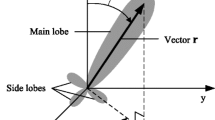Abstract
Directional antennas are a promising technology for use in mobile ad hoc environments. By consuming smaller volumes than omni directional antennas, directional antennas enable significant increases in network capacity by allowing more simultaneous transmissions to occur within a multihop wireless network. In this paper, we present some of the challenges that face asynchronous directional channel access schemes and describe how these problems can be avoided by taking a synchronous approach. We describe a communications system architecture that enables modestly directional sectored antennas to be effectively exploited in a mobile ad hoc environment. A key part of this architecture is the Directional Synchronous Unscheduled Multiple Access (DSUMA) protocol. By making intelligent decisions regarding the enabling/disabling of sector antennas, DSUMA provides an increased density of transmissions while insuring that collisions do not occur. Our results indicate how the number of sectors per node affects performance in terms of spatial reuse, the likelihood of collisions, and overall network capacity.
Similar content being viewed by others
References
R.R. Choudhury, X. Yang, R. Ramanathan and N.H. Vaidya, Using directional antennas for medium access control in ad hoc networks, in: Proc. of the 8th Internat. Conf. on Mobile Computing and Networking, ACM MOBICOM (2002) pp. 59–70.
K. Grace, SUMA – The synchronous unscheduled multiple access protocol for mobile ad hoc networks, in: Proc. of the 11th Internat. Conf. on Computer Communications and Networks, IC3N’2002 (October 2002).
V. Kanodia, A. Sabharwal, B. Sadeghi and E. Knightly, Ordered packet scheduling in wireless ad hoc networks: Mechanisms and performance analysis, in: Proc. of the 3rd ACM Internat. Symposium on Mobile Ad Hoc Networking and Computing (June 2002) pp. 58–70.
T. Nandagopal, T. Kim, X. Gao and V. Bharghavan, Achieving MAC layer fairness in wireless packet networks, in: Proc. of the 6th Annual Internat. Conf. on Mobile Computing and Networking, ACM MOBICOM (August 2000) pp. 87–98.
J. Stine, Energy conserving protocols for wireless data networks, Ph.D. dissertation, University of Texas at Austin (2001).
Wireless LAN Medium Access Control (MAC) and Physical Layer (PHY) specifications, IEEE Std 802.11 (1999).
S. Xu and T. Saadawi, Does the IEEE 802.11 MAC protocol work well in multihop wireless ad hoc networks?, IEEE Communications Magazine 39(6) (2001) 130–137.
Author information
Authors and Affiliations
Corresponding author
Rights and permissions
About this article
Cite this article
Grace, K.H., Stine, J.A. & Durst, R.C. An Approach for Modestly Directional Communications in Mobile Ad Hoc Networks. Telecommun Syst 28, 281–296 (2005). https://doi.org/10.1007/s11235-004-5573-0
Issue Date:
DOI: https://doi.org/10.1007/s11235-004-5573-0




